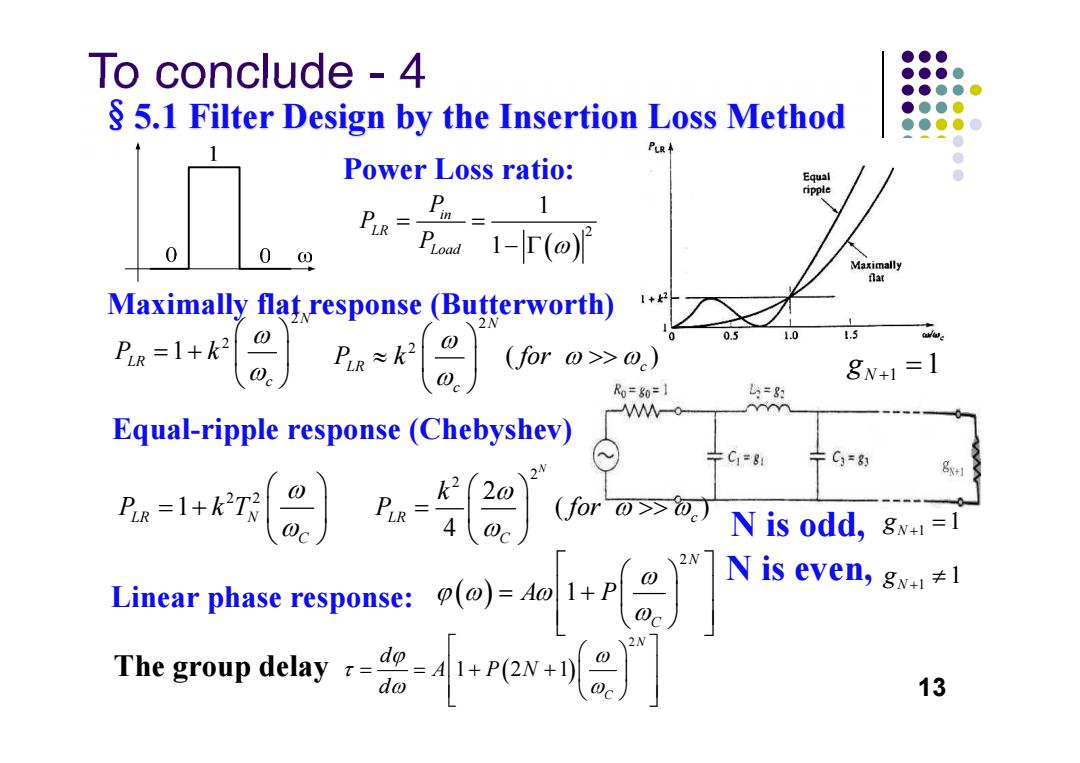
To conclude -2 ●●● ●●●● ●●●●● ●●●0 S 4.4 Basic Practical Antennas ●●●●0 ●●●0 ●●●● ● 馈电网路。 辐射单元 1(z) 射 Rpd Rloss 景 o-M R erad ad ad Z.> Rrad +Ros →+2a R=20a Rs 040 (2) R2ó (2) 6πa x台-a (4=4π*10-7H/m, Ccopper=5.8*10S/m) 11
To conclude - 2 §4.4 Basic Practical Antennas 11 2 20 ( ) rad L R 0 7 0 7 copper ( ) 2 ( 4 *10 H/m, =5.8*10 S/m) R s ( ) 6 s loss R L R a 60 ln 1 ( ) L X L a rad rad rad in rad loss P R e P R R

●●● To conclude -3 V=C e-jkoRd 1-e 2jkohihz/a ●●●● ●●0 ●●● §4.5 Propagation Rd ● ●● kohih2 2kohih2 Direct Ra R = 2sin 兰 Transmit Rectie d d antenna G.P: koh h/d <0.3rad anle G... IV2 PtGtGrhihz P= Zo Ra 1 100 40 Attenuation In practice Pr Rn n=1.5to6 10 (wx/8P) 0.4 0.2 -20Fading Small-scale 0.1 H,O -30 variation (fading) 0.04 01 0.02 0.01 0.004 9150m altitude 元,A个; 0.002 -50 0.00 10 5 202530 403060708090100150200250300400 Large-scale Frequency (GHz) -60 variation (average) 2040 12 14 16 18 20 22 24 Distance(m) 12
To conclude - 3 §4.5 Propagation In practice Attenuation n=1.5 to 6 Fading 12

To conclude -4 ●●● ●●●● ●●●●● 5.1 Filter Design by the Insertion Loss Method ●●●0 ●●●●0 PLR Power Loss ratio: ● Equal ● ripple 1 PLR= Pn= PLood 1-T() Maximally fat Maximally flat response(Butterworth) 0.3 1.0 1.5 ww. (for0>0) 8N+1=1 R0=80=1 =8别 M-o YY Equal-ripple response (Chebyshev) 宁C=81 卡C3=8的 Px=1+kT (for @>0.) Nis odd, 8w+1=1 \2N Limear phase response:( is even,gw+l≠l The group delay) 13
To conclude - 4 §5.1 Filter Design by the Insertion Loss Method Power Loss ratio: Maximally flat response (Butterworth) Equal-ripple response (Chebyshev) Linear phase response: The group delay N is odd, N is even, 13 2 1 1 in LR Load P P P 2 2 1 N LR c P k 2 2 ( ) N LR c c P k for 1 1 N g 2 2 1 LR N C P kT 2 2 2 ( ) 4 N LR c C k P for 1 1 N g 1 1 N g 2 1 N C A P 2 1 21 N C d A PN d